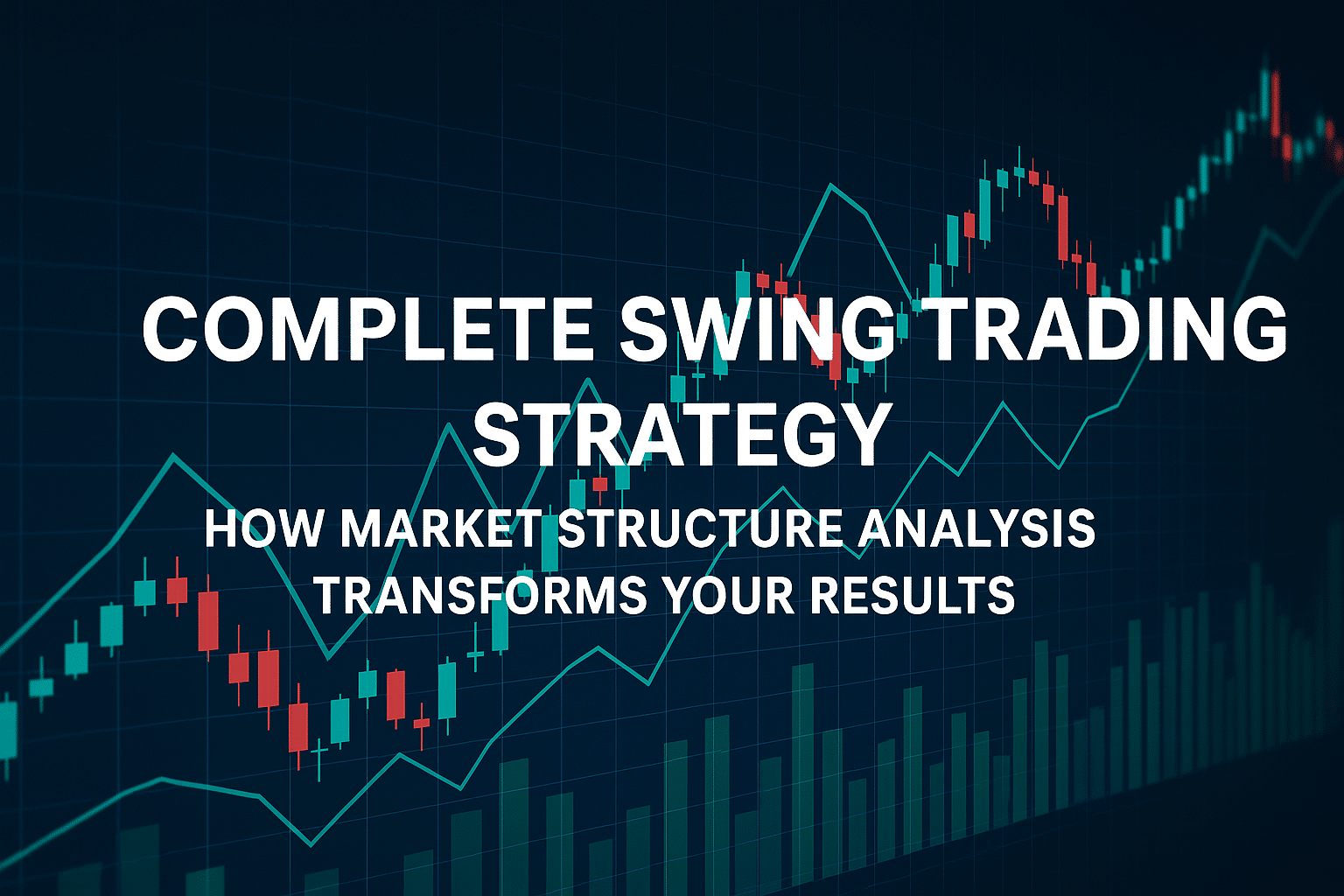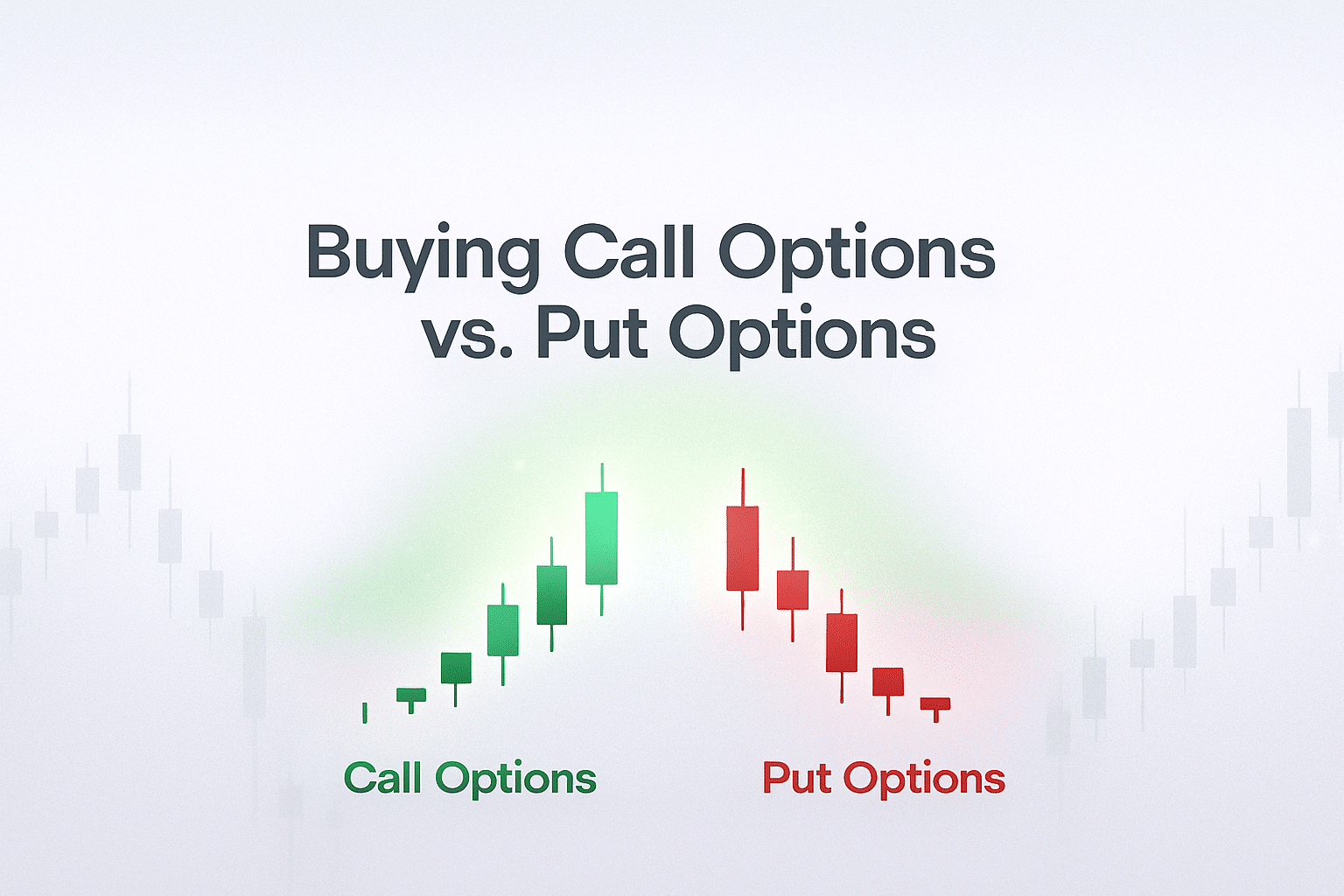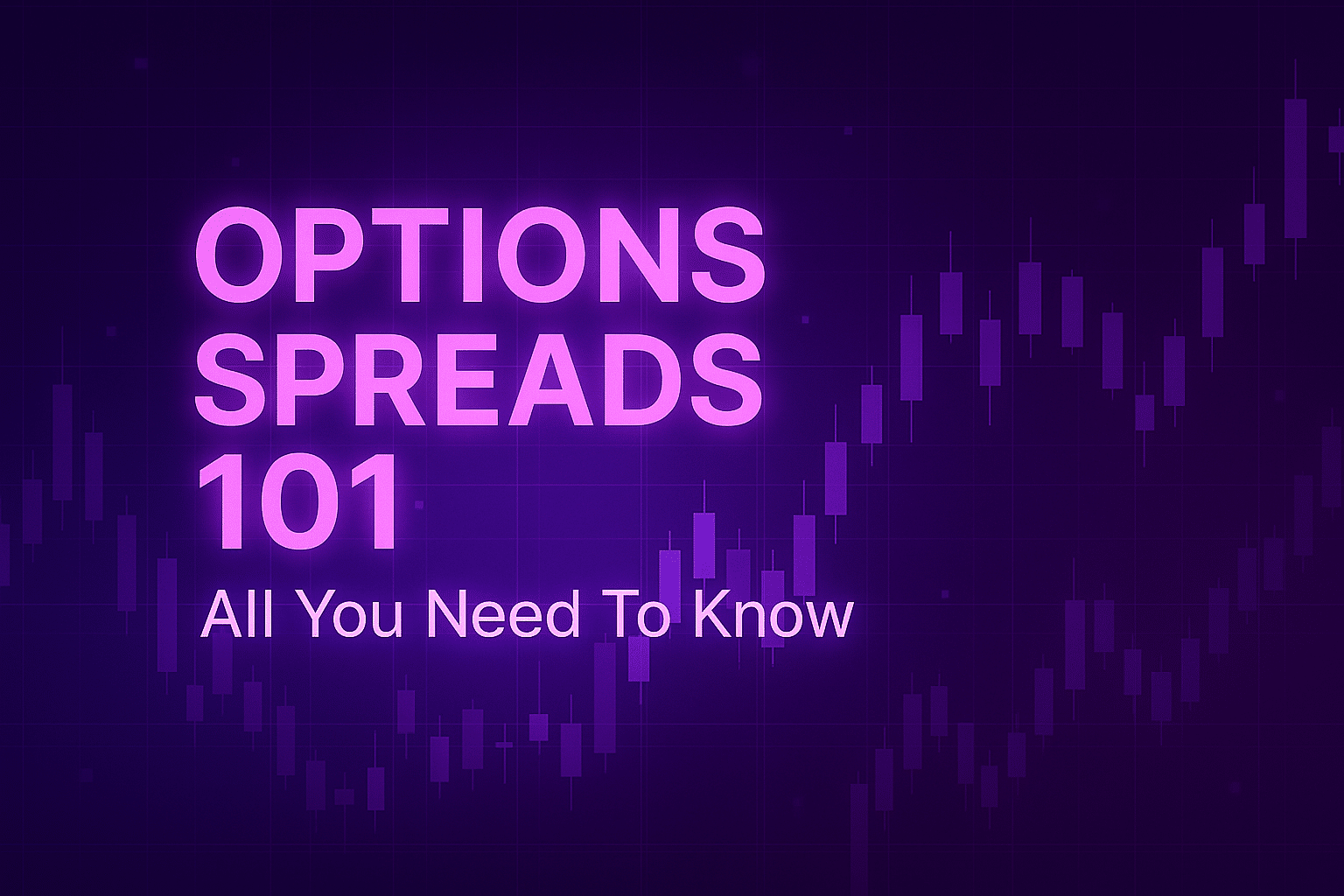Complete Swing Trading Strategy: How Market Structure Analysis Transforms Your Results
“What if you could see the hidden forces behind every technical pattern you trade?”
You’ve mastered the fundamentals. You can:
- Read charts,
- Spot patterns, and
- Identify high-probability setups.
Your technical analysis skills are solid – that’s exactly why you’re profitable some of the time.
But here’s what you’ve probably noticed: some textbook setups work flawlessly while others fail spectacularly, even when they look identical on the chart. Some support levels hold like concrete walls, while others get blown through as if they don’t exist.
There’s a reason for this – and it has nothing to do with your chart-reading skills.
And if you’d rather watch a video of the lesson rather than read, here you go:

Table of Contents
The Missing Layer Most Traders Never See
Over the past decade, something fundamental has shifted in how markets move. Options trading volume has exploded across all participant types, creating a powerful new layer of market structure that sits beneath traditional price action.
This isn’t about replacing your technical analysis – it’s about understanding WHY your patterns work when they do, and more importantly, how to identify which setups have the structural backing to actually follow through.
Think of it this way: your technical analysis shows you WHAT is happening on the charts now. The options market structure shows you WHY it’s happening and whether those forces are likely to continue in the future.
The Reality Every Swing Trader Faces
As a swing trader, you’re dealing with challenges that your technical analysis foundation handles well – but could handle even better with additional context:
- You find great-looking breakouts that immediately reverse (what if you could see that coming?)
- You struggle to know which market environments actually support sustained moves vs. when to sit out entirely
- You spend hours scanning charts hoping to find something that “looks good” (what if you could filter for setups with structural backing?)
- You’re never quite sure if your individual stock picks align with broader market forces
If any of these sound familiar, you’re experiencing the gap between what traditional technical analysis can show you and the deeper structural forces that drive today’s markets.
The GammaEdge Process
At GammaEdge, we’ve developed tools that complement your existing technical skills by revealing the options market intelligence that most traders never see. Our approach isn’t about abandoning chart patterns – it’s about understanding which patterns have institutional backing and structural support.
Instead of fighting against invisible forces you can’t see, you’ll enhance your technical analysis with the same positioning data that drives price movements across multiple timeframes.
In this guide, we’ll show you how to:
- Enhance your market analysis by adding structural context to your existing technical framework
- Build better watchlists by filtering chart patterns for those with favorable options positioning
- Improve your entry timing by understanding where institutional hedging creates predictable price responses
- Stay ahead of reversals by seeing speculator positioning shifts before they show up in price action
- Hold winners longer using multi-timeframe options analysis that confirms your technical thesis
This isn’t about learning an entirely new way to trade. It’s about adding a powerful new lens to the skills you already have.
Ready to see what’s been hiding beneath your charts all along?
Let’s dive in.
What Makes Swing Trading Unique? Why Your Technical Skills Need Additional Context
Swing trading isn’t just “day trading with a longer time horizon.” The multi-day nature of these positions introduces market dynamics that your technical analysis foundation captures well – but with some important blind spots that additional context can fill.
When you’re holding a position for days or weeks, you’re navigating forces that your price charts simply can’t show you.
The Multi-Day Time Horizon Opportunity
Your technical analysis excels at identifying patterns and shifts in momentum. However, extending that timeframe to multiple days means dealing with structural forces that significantly influence whether your technical setups will be successful.
Options positioning across different expiration cycles creates support and resistance levels that persist for days or weeks. Market makers continuously hedge these positions, creating buying and selling pressure that can either amplify or work against your technical signals.
Here’s the key insight: the same chart pattern that works as a day trade might struggle as a swing trade, not because your technical analysis was wrong, but because the underlying structural forces weren’t aligned with your setup.
The Hidden Forces Your Charts Can’t Show
Call and put speculator positioning across multiple expirations creates “structural bias” that either supports sustained moves or creates headwinds your technical levels alone can’t explain.
Market maker positioning becomes crucial over multi-day timeframes. While your technical analysis might identify a perfect setup, understanding whether market maker positioning supports or resists your directional bias can be the difference between winning and losing.
Common Challenges That Additional Context Solves
Building reliable watchlists becomes easier when you can filter your technical setups for those with favorable structural backing – identifying which patterns have the strongest foundation.
Timing entries and exits with greater precision becomes possible when you understand where options speculators are positioned and how their activity creates predictable responses.
Recognizing optimal market environments versus when to reduce exposure becomes clearer when you can see whether conditions support sustained moves or create choppy action that frustrates chart-based setups.
Your technical analysis gives you an excellent view of price action and patterns. Adding structural context shows you the “why” behind what you’re seeing and helps identify which setups have the best probability of following through.
The GammaEdge Advantage: Tools That Enhance Swing Trading
Our approach to swing trading focuses on understanding structural forces rather than simply predicting price direction. We’ve developed a systematic four-step process that gives you visibility into the options, positioning, and market dynamics that drive sustained moves.
Step 1: Market Environment Assessment – The Market Turning Framework
Understanding whether market conditions support swing trades is the foundation of everything. The Market Turning Framework integrates multiple tools to give you a complete picture:
Core Components:
- Market Trend Model for multi-timeframe momentum analysis
- Web App Dashboard for options positioning across expiration cycles
- SPX structure analysis to understand broader speculator sentiment
- Identifying when market structure favors sustained moves vs. choppy conditions
This framework answers the critical question: “Is now a good time to be swing trading?”
Rather than forcing trades in any market condition, you’ll recognize when the structural environment actually supports multi-day directional moves. This single insight can dramatically improve your win rate by keeping you out of unfavorable periods.
Step 2: Building Your Watchlist – Proprietary Equity Scans
Once market conditions are favorable, systematically identify candidates using data-driven scans that replace random chart screening with options-market intelligence:
Key Scans for Swing Traders:
- $calldomdel – Call-dominated structures showing bullish positioning
- $ncalldomdel – Call-dominated structures that are newly bullish
- $calldomdel – Call-dominated structures showing bullish positioning
- $allcalldom – Call-dominated structures showing bullish positioning for all Greeks
- $ptrans2pgex – Stocks positioned for moves from transition zones to upside targets
- $putdomdel – Put-dominated structures for bearish setups
- $nputdomdel – Put-dominated structures that are newly bearish
- $allputdom – Put-dominated structures showing bearish positioning for all Greeks
These scans identify stocks where the options market structure aligns with your directional bias, giving you a significant edge over traditional chart-pattern analysis.
This systematic approach transforms watchlist building from a time-consuming guessing game into a precise, data-driven process.
Step 3: Understanding Key Levels – Transition Zones and Targets
For each candidate stock, understand where it’s trading relative to critical structural levels that options speculators actually respect:
Key Level Analysis:
- Transition Zones (PTrans/NTrans) – Areas where market structure shifts between call/put dominance
- Upside Targets (+GEX) – Natural levels where calls concentrate, creating resistance or acceleration points
- Downside Levels (-GEX) – Put-heavy areas that can provide support or breakdown points
- Entry/Exit Timing – Using these levels for precision trade management
These aren’t arbitrary chart levels drawn by technical analysts. They’re mathematically derived from options positioning, representing areas where market maker positioning and responses are most likely to create predictable price action.
Step 4: Ongoing Position Analysis – Delta Balance & GEX Ratio
While in trades (or before entering), continuously monitor structural health to stay aligned with options positioning:
Delta Balance Tool:
- Understanding call/put positioning across future expirations (multi-timeframe analysis)
- Spotting early signs of structural weakness or strength
- Confirming your directional bias remains intact across different time horizons
- Applying the same sentiment and structure analysis used on SPX to individual stocks
GEX Ratio Integration:
- Additional confirmation of sentiment trends
- Understanding when positioning shifts might affect your trade
Key Philosophy: All multi-day trades start as day trades. Evaluate your thesis at the end of each trading day—if structure remains favorable, continue holding; if not, reassess and potentially exit.
Summary
This systematic approach transforms swing trading from chart-pattern into structured, data-driven analysis. You’re no longer guessing about market direction—you’re aligning with the same structural forces that drive price movements.
Now let’s see how this translates into daily execution.
Key Frameworks for Systematic Execution
While markets are complex, these proven frameworks will guide your decision-making using GammaEdge tools. Think of these as your “rules of thumb” for systematic swing trading execution.
The Daily Swing Trading Framework
Follow this systematic approach every trading day to stay aligned with structural forces:
- Assess Market Environment – Use Market Turning Framework to determine if conditions favor swing trades
- Run Targeted Scans – Execute scans that align with the current market structure
- Analyze Key Levels – Understand where candidates sit relative to transition zones and targets
- Monitor Ongoing Positions – Use Delta Balance and GEX Ratio to confirm structural health
- Execute with Precision – Enter/exit based on options-derived levels rather than arbitrary chart patterns
This sequence ensures you’re always working with the structural flow rather than against it.
The Ultimate Systematic Approach: PTrans2PGEX Strategy
Want to see the GammaEdge framework in its purest form? Our PTrans2PGEX strategy removes all discretion from swing trading, delivering a 100% mechanical approach that has generated consistent returns across multiple market cycles.
This strategy systematically identifies stocks breaking above their transition zones (PTrans) with clear upside targets at +GEX levels. Every entry, exit, and position sizing decision is predetermined by the structural data—no emotions, no second-guessing, just systematic execution based on options positioning.
The beauty? It requires just minutes per day to execute, yet captures the same options flows that drive sustained multi-day moves. For traders seeking to overcome the psychological challenges of discretionary decision-making, this represents the framework’s ultimate evolution.
Click HERE for a complete breakdown of this strategy (which has significantly outperformed the S&P 500 over the past 10 years).
Reading Market Structure for Swing Trading Success
Understanding market character is crucial for knowing when to be aggressive versus when to step aside entirely.
Favorable Environment Signals:
- Market Turning Framework showing supportive conditions across multiple timeframes
- Clear directional bias from SPX options positioning
- Scans produce quality candidates with favorable structural setups
- Delta Balance showing consistent positioning across future expirations
Challenging Environment Signals:
- Mixed signals from Market Turning Framework components
- Choppy SPX options positioning with conflicting timeframe signals
- Scanner results showing limited high-quality setups
- Delta Balance is displaying inconsistent or deteriorating sentiment patterns
Key Insight: The most successful swing traders know when NOT to trade. The Market Turning Framework prevents you from forcing trades in unfavorable conditions, which is often the difference between consistent profitability and frustrating losses.
The Philosophy That Enhances Every Swing Trading Journey
Traditional swing trading can sometimes become an emotional rollercoaster – the natural human tendency to hold losers too long while cutting winners too short affects even the most disciplined traders.
The GammaEdge approach provides an objective framework to support informed decision-making. Instead of relying solely on gut feelings or arbitrary rules, you now have structural data to guide your choices.
When Delta Balance and key structural levels continue to support your thesis, you have concrete reasons to stay in the trade. When structure deteriorates, you have clear signals to reassess – regardless of whether you’re winning or losing.
This structural discipline doesn’t replace your trading judgment – it enhances it. You’re still making the final decisions, but now you’re doing so with additional intelligence about what’s happening beneath the surface. The result? More confidence in your entries, better timing on your exits, and the peace of mind that comes from trading with both technical patterns and structural flow aligned in your favor.
Essential Articles for Your Swing Trading Journey
Ready to dive deeper into the GammaEdge swing trading methodology? These comprehensive guides will take you from understanding the concepts to mastering the execution.
Start with the foundational articles to build your knowledge base, then progress to the individual analysis tools for practical application.
Structure & Environment
Market Turning Framework
The complete guide to determining when market conditions actually support sustained directional moves versus when to reduce exposure entirely.
Market Trend Model Deep Dive
Master the multi-timeframe momentum analysis that forms the backbone of market environment assessment. Unlock the ability to read momentum across different time horizons.
Key Levels & Timing
Transition Zones
Understand how to identify the critical price areas where market structure shifts between call/put dominance for optimal entry timing.
Key Upside/Downside Levels
Master the key levels derived from options market structure that price respects day in and day out for precision exit timing and target setting.
Individual Analysis
Delta Balance for Swing Trading
Master multi-timeframe sentiment analysis for individual stocks, understanding how call/put positioning across different expirations affects multi-day price movements.
Market Sentiment through the GEX Ratio
Harness this powerful confirmation tool for validating sentiment trends and understanding when positioning shifts might affect your trades.
Reading Order Recommendation: Start with Market Turning Framework and Market Trend Model to understand market environment assessment. Then move to Transition Zones and Key Upside/Downside Levels for entry/exit timing. Finally, dive into Delta Balance and GEX Ratio for individual stock analysis.
Each article builds upon the previous concepts while providing specific, actionable techniques you can implement immediately in your swing trading process.
Key Takeaways for Swing Trading & Swing Traders
Important Note: While GammaEdge tools provide superior market intelligence, proper risk management and position sizing remain essential. You should develop clear If/Then statements that incorporate our key levels into your trading plan (e.g., “IF price breaks below PTrans, THEN I will exit the position”).
Whether you’re new to structure-based analysis or looking to refine your approach, remember these essential principles:
- Market environment assessment drives everything – Don’t force trades when the Market Turning Framework shows unfavorable conditions. The best trade setups fail in hostile structural environments.
- Options-driven scans enhance traditional chart screening – Build focus lists based on structural positioning to complement your technical pattern recognition, rather than hoping to find something that “looks good” on thousands of charts.
- Key levels provide precision entry/exit points – PTrans, +GEX, and -GEX levels replace arbitrary chart levels with mathematically-derived options positioning data.
- Structural monitoring maximizes trade outcomes – Delta Balance and GEX Ratio help you hold winners longer and exit deteriorating setups earlier.
- Daily systematic execution catches market shifts – Consistent application of the framework helps you adapt to changing conditions before they become obvious in price action.
Simple Starting Framework: Assess environment → Run targeted scans → Analyze key levels → Monitor structural health → Execute accordingly
The goal isn’t to predict where markets will go – it’s to align your trades with the same options flows that drive sustained price movements. When you trade with structure rather than against it, consistency follows naturally.
Next Steps: Start Swing Trading with Options Market Intelligence
Ready to transform your swing trading with structural analysis? Here’s how to get started with the systematic approach that’s already helping hundreds of successful traders align with options positioning.
The framework works – the tools are proven – the community is thriving. The only variable left is your execution.
Remember: Successful swing trading isn’t about finding the perfect chart pattern or predicting market direction. It’s about understanding the structural forces that drive sustained multi-day moves and positioning yourself accordingly.
The options market reveals speculator positioning before it shows up in price action. When you align your trades with these forces rather than fighting against them, consistency becomes the natural result.
Until next time,
Taylor
GammaEdge Co-Founder



